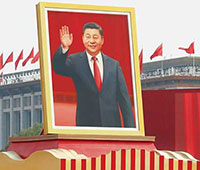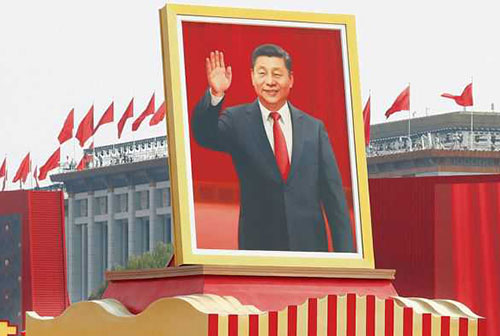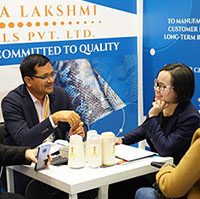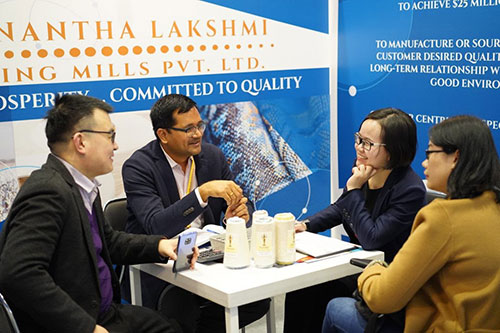FW
"To look into the critical challenges of sustainable urban living, Messe Frankfurt India will host India's first Technical Textile Hackathon on November 22. The hackathon titled "Techtextil NEXT" will build an eco-system that supports India's technical textile start-ups and enables them to develop products and prototypes with Technical Textiles, driving innovations in the industry."
 To look into the critical challenges of sustainable urban living, Messe Frankfurt India will host India's first Technical Textile Hackathon on November 22. The hackathon titled "Techtextil NEXT" will build an eco-system that supports India's technical textile start-ups and enables them to develop products and prototypes with Technical Textiles, driving innovations in the industry.
To look into the critical challenges of sustainable urban living, Messe Frankfurt India will host India's first Technical Textile Hackathon on November 22. The hackathon titled "Techtextil NEXT" will build an eco-system that supports India's technical textile start-ups and enables them to develop products and prototypes with Technical Textiles, driving innovations in the industry.
Showcasing the supply-chain of fibre to innovation & start-ups to investor stage, India's first Technical Textile Hackathon aims to potentially build business models that can be funded, scaled, and taken globally. The hackathon is expected to bring India's top 10 technical textile start-ups under one roof. While the manufacturing side will be represented by companies of specialty fibres, yarns, textiles, fabrics, products along with brands and traders, the entrepreneur side will cover SME's, start-up ecosystems and accelerators.
Build up in association with Ideas that Scale as the knowledge partner, the intense 3-hour solution-driven session at the Techtextil NEXT Hackathon will take up topics centered around India's challenges of sustainability such as ocean littering, plastic recycling, and waste disposal, and drive concepts for start-ups to collaborate with industry stakeholders to develop focused solutions using "technical textiles".
session at the Techtextil NEXT Hackathon will take up topics centered around India's challenges of sustainability such as ocean littering, plastic recycling, and waste disposal, and drive concepts for start-ups to collaborate with industry stakeholders to develop focused solutions using "technical textiles".
Techtextil India is India's leading trade fair for technical textiles and nonwovens covering the chain of technical textiles and its 12 application areas of Agrotech, Buildtech, Clothtech, Geotech, Hometech, Indutech, Medtech, Mobiltech, Oekotech, Packtech, Protech, and Sport-tech.
Technical Textile is increasingly penetrating every aspect of our daily lives such as medical masks, car seats, trekking gears, specialised sport-wear, etc without most of us noticing. What we don't realise is that we are surrounded by textiles like nonwoven fabric in every single way. The future with smart wearable textiles is also near.
The 7th edition of this event already has a strong line-up of participation from 185 companies from 12 countries including Austria, Belgium, China, France, Germany, Italy, Korea, the Netherlands, Saudi Arabia, Spain, and China/Taiwan. Some of the industry's key players such as Aditya Birla Yarns (P T Elegant), Archroma, Coated Sales, Ginni Filaments, Lenzing Ag India, Montex Glass Fiber, Reliance Industries Ltd, Saint Gobain among others will have their latest technical textile innovations spread across the exhibition space covering these application areas.
With textile stakeholders and key decision-makers on the floor, the concurrent Hackathon can enable stakeholders to engage in sustained dialogue and drive innovations in India's technical textiles industry.
The organizers believe the collaborations can potentially lead to the development of multiple market strategies.
Raj Manek, Executive Director, and Board Member, Messe Frankfurt Asia Holdings elaborated: "While Techtextil India exhibition highlights innovations in the sector, the Techtextil NEXT Hackathon is a concerted an effort to tackle today's urban living challenges with next-generation solutions. The platform has the potential to present transformative ideas."
"The subsidies given by its government and loans granted with low interest rates helped the Chinese textile industry to emerge as one of the top industries in the world. This coupled with zero per cent duty through the RCEP free trade agreement is likely to provide China with an open market, affecting medium and small textile players in India who are majorly dependent on the domestic market."
 The subsidies given by its government and loans granted with low interest rates helped the Chinese textile industry to emerge as one of the top industries in the world. This coupled with zero per cent duty through the RCEP free trade agreement is likely to provide China with an open market, affecting medium and small textile players in India who are majorly dependent on the domestic market.
The subsidies given by its government and loans granted with low interest rates helped the Chinese textile industry to emerge as one of the top industries in the world. This coupled with zero per cent duty through the RCEP free trade agreement is likely to provide China with an open market, affecting medium and small textile players in India who are majorly dependent on the domestic market.
During the last five years, India’s trade deficit with China increased to a whopping $711.298 billion. Imported Chinese goods are creating a havoc in the Indian system due to their gross undervaluation’ through congenital ‘mis-declaration. These grossly undervalued Chinese goods enter the Indian market through a fake certificate-of-origin of goods issued by a third country. This monopolised entry of Chinese goods renders the valuation rule inadequate, ineffective and obsolete.
Hasty decisions lead to a huge trade deficit
The Indian customs department is the most frontline professional organisation. However, custom officers are rarely consulted during the formulation of international trade policy or concluding multi-nation commercial agreements between India and foreign countries. The hasty decisions made by the government without a detailed analysis and feedback on real issues from ‘actual’ professionals are resulting in a humongous trade deficit with very little possibility of things improving in the near future.
rarely consulted during the formulation of international trade policy or concluding multi-nation commercial agreements between India and foreign countries. The hasty decisions made by the government without a detailed analysis and feedback on real issues from ‘actual’ professionals are resulting in a humongous trade deficit with very little possibility of things improving in the near future.
To grant further duty concessions to these Chinese goods will therefore, prove disastrous for the Indian industry as it will result in loss of tax, closure of industry, loss of jobs, rise of unemployment; social unrest; and finally, loss of foreign investors’ confidence.
Signing RCEP to result in huge losses
Ludhiana-based garment makers are seeking protection against cheap Chinese imports as they fear a huge industrial collapse and loss of employment. It is being realised that signing the RCEP agreement under such circumstances will result in huge losses for the Indian textile industry as not only do Chinese manufacturers and traders offer cheaper fabrics but the Chinese government also grants subsidies and loans to the textile industry at low interest rates.
China adopted a policy of currency devaluation between 1980 and 1992, to ‘promote exports and to restrain imports so as to improve China’s current account position.’ From the ratio of $1: 1.53 Chinese yuan in 1980, the latter had fallen to 8.72 yuan to a dollar. As a result, the country’s trade deficit of $7.7 billion in 1988 turned into a trade surplus of $8.74 billion in 1990 and by year end, its foreign exchange reserves rose to $28.6 billion. Today, that figure has swollen to $3 plus trillion.
To sustain this growth, China now aims to include India in the RCEP. India, therefore, needs to adopt a cautious approach as even a wrong decision can prove highly disastrous for its domestic market.
Extending its regional activity chain, the ZDHC Foundation will host a conference with the theme ‘Anchoring the ZDHC Programme in the domestic apparel industry’ on December 10, 2019 at The Courtyard Marriott in Mumbai, India.
The conference will highlight the issue of safe chemical usage in supply chain of Indian domestic apparel brands and will create awareness of the ZDHC Programme by sharing experiences of stakeholders in the apparel and textile sector through presentations and panel discussions. It will cover various industry topics ranging from product safety Indian regulations and enforcements, leveraging sustainability and chemical management for growth and market differentiation in the fashion business. Also, topics like chemical management in the apparel value chain perspectives from brands and chemical industry; how can the chemical industry offer sustainable products to the textile industry; success stories in implementing best practices in chemical management, will be discussed.
The vision of ZDHC is focused on the implementation of sustainable chemistry, driving innovations and environmental best practices in the textile, apparel, and leather and footwear value chains through collaborative engagement, standard-setting, and implementation projects.
Brands are moving away from using wool from mulesed sheep. By July 2023, 100 per cent of wool used by the retailer Target for clothing and bedding will be either from farms certified under the Responsible Wool Standard or equivalent standard, from farms fully traceable and verified as non-mulesed, or from recycled wool materials.
Most Australian Merinos are still mulesed. More than two billion animals end up in fashion supply chains every year. Many of them endure pain, fear and stress due to cruel mutilation practices and inadequate living conditions for the sake of clothing. Australian brands are starting to take steps toward prioritising animal welfare. Shoppers want kinder clothing and many brands are now listening. Only 55 per cent of Australians are aware of animal cruelty in the fashion industry. Of those that do know, 93 per cent are concerned about the animals used within at least one fashion category. Robust fashion policies are being aimed at reducing animal welfare risk and improving supply chain transparency. Brands want to be seen as opting to use only fabrics or textiles which do not allow for cruel animal practices or treatment while also striving for positive environmental and human welfare attributes.
"The global textile trade in the past year has experienced recorded growth since 2012, and China was among the top three largest exporters and importers of textiles. As a result, suppliers are striving to meet robust demand with innovation and eco-friendly solutions. Yarn Expo Spring will present as an the ideal sourcing platform for the industry by attracting worldwide suppliers with the potential to explore new partnerships and markets in China and globally while offering buyers strong product diversity and updated market information"
 Yarn Expo Spring, to be held from March 11 to 13, 2020 at the National Exhibition and Convention Center in Shanghai, will serve as serves as a fast-developing springboard for exhibitors to attract Chinese and international buyers.
Yarn Expo Spring, to be held from March 11 to 13, 2020 at the National Exhibition and Convention Center in Shanghai, will serve as serves as a fast-developing springboard for exhibitors to attract Chinese and international buyers.
As per the World Trade Organisation, the global textile trade in the past year has experienced recorded growth since 2012, and China was among the top three largest exporters and importers of textiles. As a result, suppliers are striving to meet robust demand with innovation and eco-friendly solutions. Yarn Expo Spring will present as an the ideal sourcing platform for the industry by attracting worldwide suppliers with the potential to explore new partnerships and markets in China and globally while offering buyers strong product diversity and updated market information.
Multiplicity of the leading fair
Eco-friendly solutions and innovations across all product categories will continue to be a major trend at Yarn Expo Spring 2020, with highlighted domestic zones including natural cotton, quality wool, green linen, chemical fibre and specialty yarn. In particular, the Fancy and Specialty Yarn Zone will feature the Fancy Yarn Vision display area, which was first introduced at Yarn Expo Autumn 2019. Meanwhile, international pavilions and zones showcasing an increasing number of strong suppliers include India Pavilion and the Pakistan Zone.
Ravindranathan Narayanasamy, Director of the Cotton Textiles Export Promotion Council (TEXPROCIL), organisers of India Pavilion describes the fair as a key place to do business face-to-face in China: “The visitors to Yarn Expo are very professional and match our exhibitors’ expectations. Some large Chinese importers visited our booths, and I’ve noticed this edition there are a lot of new importers who haven’t bought from India before.” He also acknowledges the increase and diversity in visitors: “In addition to the local market, we have seen a lot more overseas buyers, from Korea, Japan, the US, a lot from Europe and some from Russia. We’re really happy with our participation in the fair as this is a global meeting point. This is definitely the best fair in China, and one of the best in the world.”
Yarn Expo Spring and the other four concurrent fairs will bring the whole textile supply chain to one ground to enable their exhibitors and visitors to strengthen business contacts and discover new opportunities in the industry together.
"One of the primary factors driving migration is the planned separation of Old Navy from Gap Inc. and its brands, which include Gap, Banana Republic and Athleta. The separation will enable each of these brands to maximise their focus, align their investments to meet unique business needs and to optimise cost structures to deliver profitable growth"
 Even as it deals with problems like store traffic, sluggish retail and the complications of splitting off Old Navy into a separate company, Gap Inc plans to limit its exposure to sourcing from China. The company recently released its first quarter results that clearly stated the topic currently impacting the entire industry is US’ intent to impose more tariffs on clothing manufactured in China
Even as it deals with problems like store traffic, sluggish retail and the complications of splitting off Old Navy into a separate company, Gap Inc plans to limit its exposure to sourcing from China. The company recently released its first quarter results that clearly stated the topic currently impacting the entire industry is US’ intent to impose more tariffs on clothing manufactured in China
Separation of Old Navy fuelling China exodus
To dodge the impact of these potential tariffs, Gap has been migrating its sourcing out of China for the last several years. Three years ago, the brand manufactured around 25 per cent of its products in China. However, now this has declined to 21 per cent. Of this, apparel manufacturing constitutes only 16 per cent which is significantly lower than the relevant portions of the industry.”
One of the primary factors driving migration is the planned separation of Old Navy from Gap Inc. and its brands, which include Gap, Banana Republic and Athleta. The separation will enable each of these brands to maximise their focus, align their investments to meet unique business needs and to optimise cost structures to deliver profitable growth. 
Brands adding new stores
During Q1 that ended on May 4, Old Navy recorded a flat traffic at its stores with its market share gains also being modest. The brand added six new stores during the quarter while it plans to open another 20 units in the second quarter. Besides offline operations, its e-commerce operations are also growing in double digits. The brand’s buy online pickup-in store program continues to help it to understand the intersection of offline and online shopping behavior for the Old Navy customer.
On the other hand, Gap Inc aims to regain its profitability through improvements in inventory, product assortment and cost structure. The brand closed eight stores primarily in North America in the first quarter, ending the period with 3,335 company-operated stores. It now expects to close about 230 specialty stores over the next two years.
One of North America’s fastest growing athletic brands, Athleta plans to add roughly 25 new stores in 2019 versus its historical average of 15 to 20 openings per year. Part of Athleta’s success is its brand identity and commitment to sustainability. The brand just celebrated its first year as B Corp by announcing progress against its sustainability goals, including 60 percent of materials now being made from sustainable fibers.
From product perspective, the design and merchandising teams of Gap Inc were able to significantly redesign the fall season, with even more ability to influence the holiday period. The brand focused on establishing its strength in denim, with improved quality fit and silhouettes. It now aims to focus on a better product assortment, leaner inventory and an effective cost structure.
Bangladesh’s earnings from exports of sweaters have grown 15.82 per cent over the last year. Sweater manufacturers have upgraded machinery and technology to go from manual to automated. Technological upgradation has contributed a lot to increase exports earnings. Installation of new technology has improved the quality of products as well as capacity. As a result, global buyers place more work orders, which has pushed export earnings up. Bangladesh has gained from the ongoing trade conflict between the United States of America and China. While wages in China went up, higher US tariffs, promoted buyers to shift their business to other countries, especially Bangladesh. The country offers quality products at a lucrative price, giving it an opportunity to grab a bigger share of the sweater market.
However, with rising export earnings, there has been no jump in profit margins because of the sharp rise in production costs. Buyers have become stingy in paying. The country is moving toward value addition and better productivity in order to remain competitive in global markets and sees a huge scope for expanding its export earnings as it has the production capacity to meet any rise in demand.
India’s leather exports to the US grew about seven per cent in the last four months. The US-China trade war offers huge opportunities to Indian leather exporters to raise shipments to the United States.
India is making efforts to boost leather exports. Despite the global economic slowdown, production and employment in the leather sector have increased. Also, this is the only industry where exports of value-added products are almost five times more than the import of inputs/components/accessories and capital goods. The industry is undertaking a multi-pronged approach including product and market diversification, attracting investments, increasing capacities and also developing skills of workers so as to increase its global market share in the coming years. Currently, Europe accounts for about 70 per cent of leather exports from India. The sector employs about 42 lakh people and is labor intensive. The footwear sub-sector accounts for half of India’s leather exports. The leather garment sub-sector produces 16 million pieces a year and accounts for one-tenth of exports.
The entitlement rate for leather garment sector for duty-free imports of raw material may be increased from three to five per cent. The move would help in increasing the availability of raw materials at affordable rates.
Millennials and Gen Z are becoming aware of the massive ecological damage that fast fashion is having on the planet. It’s no secret that fast fashion has been responsible for a catastrophic level of environmental pollution. Overt use of raw materials, water pollution and greenhouse gas emissions are only part of the story. This circular buy, wear and toss behavior is impacting landfills and becoming a major carbon contributor. Fast fashion has also played a very dark role in contributing to black market trafficking of forced labor.
There is evidence the seemingly unstoppable growth of fast fashion giants H&M and Zara may be slowing, or at least changing. H&M plans to close 160 stores. The fashion giant was hit hard in mid-2018, after accumulating huge unsold inventory, forcing significant discounting to clear out the goods. The effect of this resulted in unexpected reductions in profits for the sixth straight quarter.
Contrary to the forces behind fast fashion, there is evidence of movement by consumers of all ages and demographics towards buying fewer but higher-quality basics that can be mixed, matched and re-worn, even with the addition of some great vintage accessories. Significant changes are underway—away from what’s trending and toward what’s stylish.
Thanks to the tariff privileges received from the US under its Generalised System of Preferences (GSP), Cambodia's footwear and travel goods exports increased dramatically in the first nine months of this year. The items, which were previously taxed between 4.5 and 20 per cent, can now enter the US duty-free under the expanded program.
Approximately 5,000 products from 122 beneficiary developing countries and territories – including 43 least-developed countries – are eligible for duty-free export to the US. The US’ and the EU’s preferential trade schemes have been very beneficial to the Kingdom’s footwear and travel goods exports which reached some 4.723 billion units – worth $385 million – in the first nine months of this year, increasing by 88 per cent compared to the same period last year
The Kingdom remained among the top 10 footwear exporters, with exports valued at over $1 billion last year, a 19 per cent increase from 2017, data from the International Labour Organisation released in August revealed. It’s main export markets included EU (46 per cent), the US (17 per cent), Japan (12 per cent) and Canada (5 per cent)












